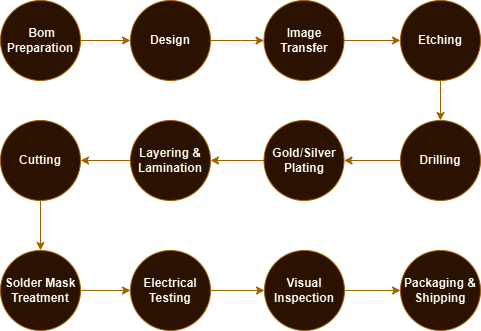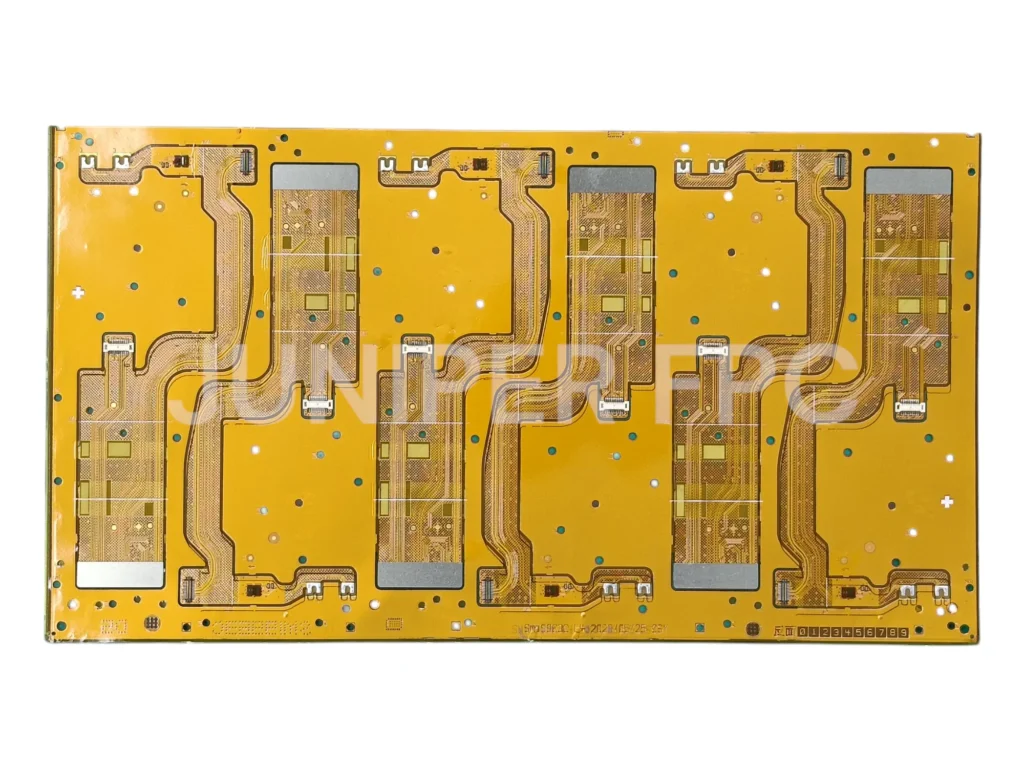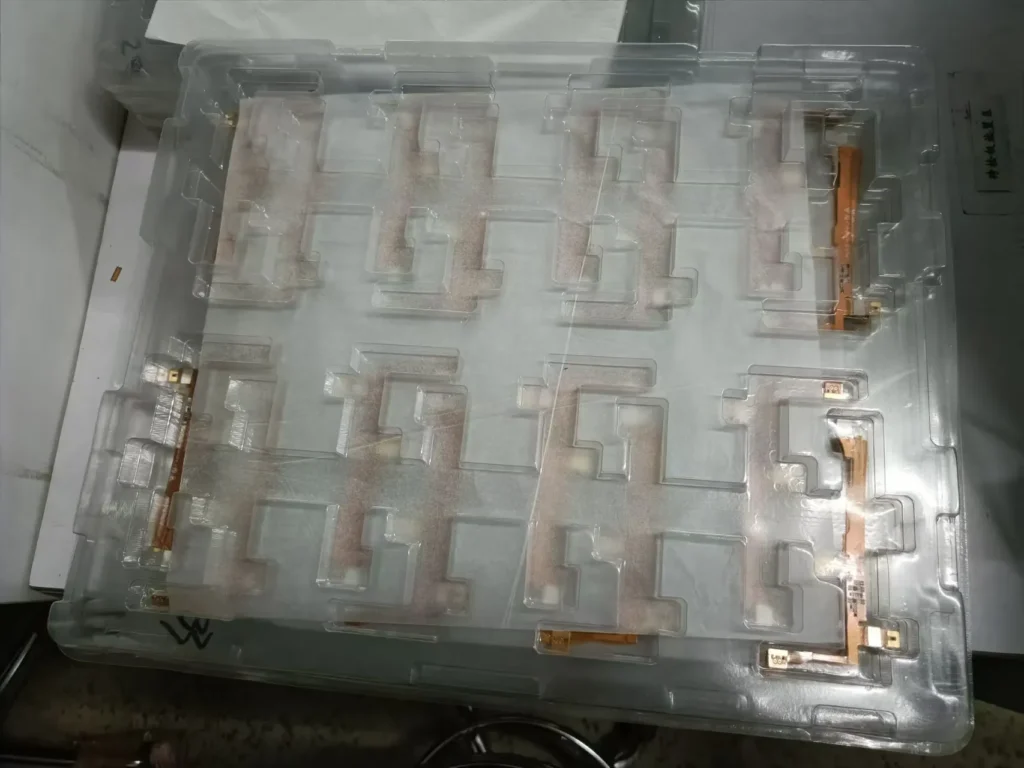The flexible PCB manufacturing process is a complex, multi-step journey that ensures the durability, flexibility, and performance of the final product. Understanding this process is essential for anyone involved in designing or sourcing flexible PCBs for various applications.
The flexible PCB manufacturing process includes design, material selection, production, and testing phases. Each stage requires precision and strict quality control to produce durable, high-performance circuits. Understanding each phase is key to creating flexible PCBs that meet your specific needs. Below Juniper FPC made a flow chart for your better understanding.

Juniper FPC as the leading manufacture of flex PCB and rigid-flex PCBs, will tell you the different stages of the flexible PCB manufacturing process in details.
1. Design Phase: From Concept to Layout
Juniper FPC could provide the flex PCB design support or turnkey flex PCB per your request. At design phase, using design software is the first step. Common design software for flexible PCBs includes Altium Designer, Eagle, and KiCAD, which allow designers to create detailed schematics and layouts.
Ususally send the Gerber files to the manufacturer for flex PCB prototypes and mass production.Gerber file define the flex PCB’s layers, drill holes, and copper traces, ensuring precise fabrication in flex PCB prototypes and mass production.
Design tool CAD software help create a precise layout that meets the required specifications for performance and flexibility.
2. Material Preparation: Selecting the Right Substrate and Coppper
Choosing the correct materials is vital for ensuring that the flexible PCB performs well under stress and maintains reliability throughout its lifespan.
Flexible PCBs typically use materials like polyimide (PI) or polyester (PET) for substrates. Metal layers, usually copper, are used for the circuit traces. The material selection impacts the board’s flexibility, durability, and electrical properties.
Polyimide (PI) is one of the most common substrates for flexible PCBs due to its excellent thermal stability and flexibility. In contrast, polyester (PET) is more cost-effective but offers lower performance. The selection of the base material depends on the application—whether the PCB needs to withstand high temperatures, be flexible for wearable electronics, or be light yet strong for aerospace applications. Copper is typically used for the metal layer because of its excellent conductivity, but alternative metals may be used depending on the specific requirements.
Below the material chart:
Explanation:
- Flexibility: Refers to the ability of the material to bend and deform. Flexible materials are more suitable for applications that require bending and folding.
- Thermal Stability: Refers to the material’s performance at high temperatures. Materials with high thermal stability can better withstand extreme temperature variations.
- Chemical Resistance: Refers to the material’s resistance to acids, bases, solvents, and other chemicals.
- Mechanical Strength: Refers to the material’s ability to resist tension and impact under external forces.
- Moisture Absorption: The ability of the material to absorb moisture. Low moisture absorption helps prevent performance degradation in humid environments.
- Dielectric Properties: Refers to the insulating properties of the material, affecting signal transmission, impedance control, etc.
- Cost: The relative manufacturing cost of the material, which typically influences the economic feasibility of choosing a material.
| Material | Flexibility | Thermal Stability | Chemical Resistance | Mechanical Strength | Moisture Absorption | Dielectric Properties | Cost |
| Polyimide | Excellent | High (can withstand temperatures above 250°C) | Very good (resistant to most chemicals) | High (good tensile strength) | Low | Excellent (high insulation, suitable for high-frequency circuits) | High |
| Polyester | Good | Moderate (temperature resistance around 150°C) | Good (resistant to some chemicals) | Medium (lower mechanical strength) | Moderate | Good (suitable for medium to low-frequency circuits) | Medium |
| Liquid Crystal Polymer | Excellent | Very high (can withstand temperatures up to 300°C) | Very good (resistant to strong acids and bases) | High (good tensile strength and impact resistance) | Low | Excellent (good insulation, suitable for high-frequency applications) | High |
| Polyether Ether Ketone (PEEK) | Medium | Very high (can withstand temperatures up to 300°C) | Very good (resistant to most chemicals) | Very high (excellent tensile strength and impact resistance) | Low | Good (moderate insulation, suitable for high-temperature environments) | High |
| Thermoplastic Polyurethane (TPU) | Good | Moderate (temperature resistance around 120°C-180°C) | Good (resistant to oils and some solvents) | High (good tensile strength and flexibility) | Moderate | Good (suitable for low-frequency or general electrical applications) | Medium-Low |
3. Production Process: From Fabrication to Testing
The production of flexible PCBs involves several essential steps to form the circuit. These include photolithography, etching, lamination, and drilling. Each step needs to be executed with precision to ensure high-quality results.
Photolithography is used to transfer the circuit design onto the PCB substrate. The board is then etched to remove excess material, followed by lamination to bond multiple layers. Drilling creates holes for vias, and soldering completes the process.
The production process begins with applying a photoresist layer onto the flexible substrate, followed by exposure to UV light to transfer the design. This is followed by etching, where unwanted copper is removed. In multi-layered flexible PCBs, lamination combines layers under heat and pressure to ensure solid electrical connections. Drilling and vias are created to enable connections between different layers of the PCB. Throughout this process, strict quality control measures are enforced to ensure that each step meets industry standards.

In Juniper FPC, we have the professional equipment and inspectors for assuring good quality goods to customers.
4. Quality Control and Testing: Ensuring Reliability
Quality control is a critical part of flexible PCB manufacturing. It ensures that the final product performs as expected in real-world conditions.
Testing methods such as electrical testing, thermal testing, and pressure testing ensure that the flexible PCB meets the required standards for performance and reliability.
Once the flexible PCB is manufactured, several tests are conducted to verify its functionality and reliability. Electrical testing checks the integrity of the connections, ensuring no short circuits or open circuits. Thermal testing simulates real-world conditions to verify the PCB can withstand high and low temperatures. Pressure testing ensures the board’s flexibility and mechanical strength are intact. These tests help detect potential failures before the PCB is shipped to the customer, ensuring it will perform effectively in its final application.
5. Delivery and Logistics: From Factory to Customer
Once the flexible PCB is completed and passes all necessary tests, the final step is the delivery process.
The delivery phase involves packaging the flexible PCB to prevent damage during shipping, followed by coordination of logistics to ensure timely delivery to the customer.
Efficient logistics and packaging are essential to ensure that flexible PCBs arrive safely and on time. Proper packaging prevents damage from environmental factors like moisture or static during transportation. Logistics management involves coordinating with freight companies and monitoring shipments to ensure timely delivery, especially in industries where deadlines are crucial, such as medical devices or consumer electronics. Some suppliers even offer express shipping options for fast turnarounds.

Juniper FPC uses insolation foams such as EPE foam, PET, cartons,blister and other methods to protect the goods.
Summary
The flexible PCB manufacturing process requires a series of precise steps, from design to testing, ensuring that each product meets strict quality standards for performance and reliability.
